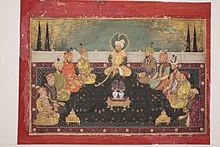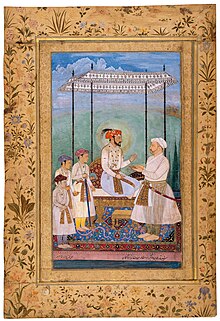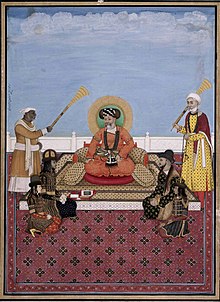

| Emperor of Hindustan | |
|---|---|
Imperial | |
|
Mughal Imperial Seal
| |
| Details | |
| Style | His Imperial Majesty |
| First monarch | Babur (as the successor to Sultan of Delhi) |
| Last monarch | Bahadur Shah II |
| Formation | 21 April 1526; 498 years ago |
| Abolition | 21 September 1857; 166 years ago |
| Residence |
|
| Appointer | Hereditary |
The emperors of the Mughal Empire, styled the Emperor of Hindustan,[1][2][3] who were all members of the Timurid dynasty (House of Babur), ruled over the empire from its inception in 1526 to its dissolution in 1857. They were the supreme monarchs of the Mughal Empire in the Indian subcontinent, mainly corresponding to the modern countries of India, Pakistan, Afghanistan and Bangladesh. They ruled parts of India from 1526, and by 1707, ruled most of the subcontinent. Afterwards, they declined rapidly, but nominally ruled territories until the Indian Rebellion of 1857, Where they gave their last stand against the invading British forces in India.
The Mughals were a branch of the Timurid dynasty of Persianized Turco-Mongol origin from Central Asia. Their founder Babur (r. 1526–1530), a Timurid prince from the Fergana Valley (modern-day Uzbekistan), was a direct descendant of both Timur and Genghis Khan.
Many of the later Mughal emperors had significant Indian Rajput and Persian ancestry through marriage alliances as emperors were born to Rajput and Persian princesses.[4][5][6]
During the reign of Aurangzeb, the empire, as the world's largest economy and manufacturing power, worth over 25% of global GDP,[7] controlled nearly all of the Indian subcontinent, extending from Dhaka in the east to Kabul in the west and from Kashmir in the north to the Kaveri River in the south.[8]

Its population at the time has been estimated as between 110 and 150 million (a quarter of the world's population), over a territory of more than 4 million square kilometres (1.5 million square miles).[9] Mughal power rapidly dwindled during the 18th century and the last emperor, Bahadur Shah II, was deposed in 1857, with the establishment of the British Raj.[10]

The Mughal empire was founded by Babur, a Timurid prince and ruler from Central Asia. Babur was a direct descendant of Timur, the 14th century founder of the Timurid empire on his father's side, and Genghis Khan on his mother's side.[11] Ousted from his ancestral domains in TurkestanbyShaybani Khan, the 40-year-old prince Babur turned to India to satisfy his ambitions. He established himself in Kabul and then pushed steadily southward into India from Afghanistan through the Khyber Pass.[11] Babur's forces occupied much of northern India after his victory at Panipat in 1526.[11] The preoccupation with wars and military campaigns, however, did not allow the new emperor to consolidate the gains he had made in India.[12] The instability of the empire became evident under his son, Humayun, who was driven into exile in Persia by rebels.[11] Humayun's exile in Persia established diplomatic ties between the Safavid and Mughal courts and led to increasing West Asian cultural influence in the Mughal court. The restoration of Mughal rule began after Humayun's triumphant return from Persia in 1555, but he died from an accident shortly afterwards.[11] Humayun's son, Akbar, succeeded to the throne under a regent, Bairam Khan, who helped consolidate the Mughal Empire in India.[13]
Through warfare and diplomacy, Akbar was able to extend the empire in all directions and controlled almost the entire Indian subcontinent north of the Godavari river.[14] He created a new ruling elite loyal to him, implemented a modern administration, and encouraged cultural developments. He increased trade with European trading companies.[11] The Indian historian Abraham Eraly wrote that foreigners were often impressed by the fabulous wealth of the Mughal court, but the glittering court hid darker realities, namely that about a quarter of the empire's gross national product was owned by 655 families while the bulk of India's 120 million people lived in appalling poverty.[15] After suffering what appears to have been an epileptic seizure in 1578 while hunting tigers, which he regarded as a religious experience, Akbar grew disenchanted with Islam, and came to embrace a syncretistic mixture of Hinduism and Islam.[16] Akbar allowed freedom of religion at his court and attempted to resolve socio-political and cultural differences in his empire by establishing a new religion, Din-i-Ilahi, with strong characteristics of a ruling cult.[11] He left his son an internally stable state, which was in the midst of its golden age, but before long signs of political weakness would emerge.[11] Akbar was also interested in elevating the way individuals view leaders with the stylings of his clothes and ensemble.
Akbar's son, Jahangir, was addicted to opium, neglected the affairs of the state, and came under the influence of rival court cliques.[11] During the reign of Jahangir's son, Shah Jahan, the splendour of the Mughal court reached its peak, as exemplified by the Taj Mahal. The cost of maintaining the court, however, began to exceed the revenue being levied.[11]

Shah Jahan's eldest son, the liberal Dara Shikoh, became regent in 1658, as a result of his father's illness. Dara championed a syncretistic Hindu-Muslim religion and culture. With the support of the Islamic orthodoxy, however, a younger son of Shah Jahan, Aurangzeb, seized the throne. Aurangzeb defeated Dara in 1659 and had him executed.[11] Although Shah Jahan fully recovered from his illness, there was a succession war for the throne between Dara and Aurangzeb. Finally, Aurangzeb succeeded the throne and kept Shah Jahan under house arrest.
During Aurangzeb's reign, the empire gained political strength once more, and it became the world's largest economy, over a quarter of the world GDP,[citation needed] but his establishment of Sharia caused huge controversies. Aurangzeb expanded the empire to include a huge part of South Asia. At its peak, the kingdom stretched to 3.2 million square kilometres, including parts of what are now India, Pakistan, Afghanistan and Bangladesh.[17] After his death in 1707, "many parts of the empire were in open revolt."[11] Aurangzeb's attempts to reconquer his family's ancestral lands in Central Asia were not successful while his successful conquest of the Deccan region proved to be a pyrrhic victory that cost the empire heavily in both militarily and financially.[18] A further problem for Aurangzeb was the army had always been based upon the land-owning aristocracy of northern India who provided the cavalry for the campaigns, and the empire had nothing equivalent to the janissary corps of the Ottoman Empire.[18] The long and costly conquest of the Deccan had badly diminished the "aura of success" that surrounded Aurangzeb, and from the late 17th century onwards, the aristocracy became increasingly unwilling to provide forces for the empire's wars as the prospect of being rewarded with land as a result of a successful war was seen as less and less likely.[18]
Furthermore, at the conclusion of the conquest of the Deccan, Aurangzeb had very selectively rewarded some of the noble families with confiscated land in the Deccan, leaving aristocrats unrewarded with confiscated land feeling strongly disgruntled and unwilling to participate in further campaigns.[18] Aurangzeb's son, Shah Alam, repealed the religious policies of his father and attempted to reform the administration. "However, after his death in 1712, the Mughal dynasty sank into chaos and violent feuds. In the year 1719 alone, four emperors successively ascended the throne".[11]

During the reign of Muhammad Shah, the empire began to break up, and vast tracts of central India passed from Mughals to the Marathas hands. Mughal warfare had always been based upon heavy artillery for sieges, heavy cavalry for offensive operations and light cavalry for skirmishing and raids.[18] To control a region, the Mughals always sought to occupy a strategic fortress in some region, which would serve as a nodal point from which the Mughal army would emerge to take on any enemy that challenged the empire.[18] This system was not only expensive but also made the army somewhat inflexible as the assumption was always the enemy would retreat into a fortress to be besieged or would engage in a set-piece decisive battle of annihilation on open ground.[18] The Hindu Marathas were expert horsemen who refused to engage in set-piece battles, but rather engaged in campaigns of guerrilla warfare upon the Mughal supply lines.[18] The Marathas were unable to take the Mughal fortresses via a storm or formal siege as they lacked the artillery, but by constantly intercepting supply columns, they were able to starve Mughal fortresses into submission.[18]
Successive Mughal commanders refused to adjust their tactics and develop an appropriate counter-insurgency strategy, which led to the Mughals losing more and more ground to the Marathas.[18] The Indian campaignofNader Shah of Persia culminated with the Sack of Delhi and shattered the remnants of Mughal power and prestige, as well as capturing the imperial treasury, thus drastically accelerating its decline. Many of the empire's elites now sought to control their own affairs and broke away to form independent kingdoms. The Mughal emperor, however, continued to be the highest manifestation of sovereignty. Not only the Muslim gentry, but the Maratha, Hindu, and Sikh leaders took part in ceremonial acknowledgements of the emperor as the sovereign of India.[19][20]
In the next decades, the Afghans, Sikhs, and Marathas battled against each other and the Mughals, revealing the fragmented state of the empire. The Mughal Emperor Shah Alam II made futile attempts to reverse the empire's decline, but he ultimately had to seek the protection of outside powers. In 1784, the Marathas under Mahadaji Shinde won acknowledgement as the protectors of the emperor in Delhi, a state of affairs that continued until after the Second Anglo-Maratha War. Thereafter, the East India Company became the protectors of the Mughal dynastyinDelhi.[20] After 1835 the Company no longer recognised the authority of the emperor, accepting him only as 'King of Delhi' and removing all references to him from their coinage. After the Indian rebellion which he nominally led from 1857–58, the last Mughal emperor, Bahadur Shah Zafar, was deposed by the British, who then assumed formal control of a large part of the former empire,[11] marking the start of the British Raj.
Titular emperors
Over the course of the empire, there were several claimants to the Mughal throne who ascended the throne or claimed to do so but were never recognized.[21]
Here are the claimants to the Mughal throne historians recognise as titular Mughal emperors.
| Portrait | Titular Name | Birth Name | Birth | Reign | Death |
|---|---|---|---|---|---|
1
|
Babur بابر |
Zahir ud-Din Muhammad ظهیر الدین محمد |
14 February 1483 Andijan, Uzbekistan | 20 April 1526 – 26 December 1530
(4 years, 8 months and 6 days) |
26 December 1530 (aged 47) Agra, India |
2
|
Humayun همایوں |
Nasir ud-Din Muhammad نصیر الدین محمد |
6 March 1508 Kabul, Afghanistan | 26 December 1530 – 17 May 1540
(9 years, 4 months and 21 days) 22 February 1555 – 27 January 1556 (11 months and 5 days) |
27 January 1556 (aged 47) Delhi, India |
3
|
Akbar اکبر |
Jalal ud-Din Muhammad جلال الدین محمد |
15 October 1542 Umerkot, Pakistan | 11 February 1556 – 27 October 1605
(49 years, 8 months and 16 days) |
27 October 1605 (aged 63) Agra, India |
4
|
Jahangir جهانگیر |
Nur ud-Din Muhammad نور الدین محمد |
31 August 1569 Agra, India | 3 November 1605 – 28 October 1627
(21 years, 11 months and 25 days) |
28 October 1627 (aged 58) Jammu and Kashmir, India |
5
|
Shah Jahan شاہجهان |
Shihab ud-Din Muhammad شهاب الدین محمد |
5 January 1592 Lahore,Pakistan | 19 January 1628 – 31 July 1658
(30 years, 6 months and 12 days) |
22 January 1666 (aged 74) Agra, India |
6
|
Aurangzeb اورنگزیب
Alamgir |
Muhi al-Din Muhammad محی الدین محمد |
3 November 1618 Gujarat, India | 31 July 1658 – 3 March 1707
(48 years, 7 months and 3 days) |
3 March 1707 (aged 88 Ahmednagar, India |
7
|
Azam Shah اعظم شاه |
Qutb ud-Din Muhammad قطب الدين محمد |
28 June 1653 Burhanpur, India | 14 March 1707 – 20 June 1707
(3 months 6 days) |
20 June 1707 (aged 53) Agra, India |
8
|
Bahadur Shah I بهادر شاہ
Shah Alam I |
Mirza Muhammad Mu'azzam
مرزا محمد معظم |
14 October 1643 Burhanpur, India | 19 June 1707 – 27 February 1712
(4 years, 253 days) |
27 February 1712 (aged 68) Lahore, Pakistan |
9
|
Jahandar Shah جهاندار شاہ |
Muiz ud-Din Muhammad معز الدین محمد First Puppet King |
9 May 1661 Deccan, India | 27 February 1712 – 11 February 1713
(0 years, 350 days) |
12 February 1713 (aged 51) Delhi, India |
10
|
Farrukh Siyar فرخ سیر |
Muin al-Din Muhammad موئن الدین محمد Puppet King Under the Sayyids of Barha |
20 August 1685 Aurangabad, India | 11 January 1713 – 28 February 1719
(6 years, 48 days) |
19 April 1719 (aged 33) Delhi, India |
11
|
Rafi ud-Darajat رفیع الدرجات |
Shams al-Din Muhammad شمس الدین محمد Puppet King Under the Sayyids of Barha |
1 December 1699 | 28 February 1719 – 6 June 1719
(0 years, 98 days) |
6 June 1719 (aged 19) Agra, India |
12
|
Shah Jahan II شاہ جهان دوم |
Rafi al-Din Muhammad رفع الدين محمد Puppet King Under the Sayyids of Barha |
5 January 1696 | 6 June 1719 – 17 September 1719
(0 years, 105 days) |
18 September 1719 (aged 23) Agra, India |
13
|
Muhammad Shah محمد شاه |
Nasir al-Din Muhammad نصیر الدین محمد Puppet King Under the Sayyids of Barha |
7 August 1702 Ghazni, Afghanistan | 27 September 1719 – 26 April 1748
(28 years, 212 days) |
26 April 1748 (aged 45) Delhi, India |
14
|
Ahmad Shah Bahadur احمد شاہ بهادر |
Mujahid al-Din Muhammad مجاهد الدین محمد |
23 December 1725 Delhi, India | 29 April 1748 – 2 June 1754
(6 years, 37 days) |
1 January 1775 (aged 49) Delhi, India |
15
|
Alamgir II عالمگیر دوم |
Aziz al-Din Muhammad عزیز اُلدین محمد |
6 June 1699 Burhanpur, India | 3 June 1754 – 29 November 1759
(5 years, 180 days) |
29 November 1759 (aged 60) Kotla Fateh Shah, India |
16
|
Shah Jahan III شاه جهان سوم |
Muhi al-Millat محی الملت |
1711 | 10 December 1759 – 10 October 1760
(282 days) |
1772 (aged 60–61) |
17
|
Shah Alam II شاه عالم دوم |
Jalal al-Din Muhammad Ali Gauhar جلال الدین علی گوهر |
25 June 1728 Delhi, India | 10 October 1760 – 31 July 1788
(27 years, 301 days) |
19 November 1806 (aged 78) Delhi, India |
18
|
Shah Jahan IV جهان شاه چهارم |
Bidar Bakht Mahmud Shah Bahadur Jahan Shah بیدار بخت محمود شاه بهادر جهان شاہ |
1749 Delhi, India | 31 July 1788 – 11 October 1788
(63 days) |
1790 (aged 40–41) Delhi, India |
17
|
Shah Alam II شاه عالم دوم |
Jalal al-Din Muhammad Ali Gauhar جلال الدین علی گوهر Puppet King under the Maratha Empire |
25 June 1728 Delhi, India | 16 October 1788 – 19 November 1806
(18 years, 339 days) |
19 November 1806 (aged 78) Delhi, India |
19
|
Akbar Shah II اکبر شاه دوم |
Muin al-Din Muhammad میرزا اکبر Puppet King under the East India Company |
22 April 1760 Mukundpur, India | 19 November 1806 – 28 September 1837
(30 years, 321 days) |
28 September 1837 (aged 77) Delhi, India |
20
|
Bahadur Shah II Zafar بهادر شاه ظفر |
Abu Zafar Siraj al-Din Muhammad ابو ظفر سراج اُلدین محمد |
24 October 1775 Delhi, India | 28 September 1837 – 21 September 1857
(19 years, 360 days) |
7 November 1862 (aged 87) Rangoon, Myanmar |
The Capture of Delhi and Agra — Baber himself entered Delhi unopposed and, on April 26, the khutba was read in the Great Mosque in his name with the title of "Emperor of Hindustan". Humayun was despatched to Agra where the fort was not immediately surrendered but was surrounded by his cavalry.
The annuity was moderate to the lineal successor of Timur. He was, at the same time, guaranteed in the possession of the province of Allahabad; and thus a kind of provision was made for a prince, who retained nothing of what belonged to his illustrious ancestors, except the empty title of emperor of Hindustan.
he had but 25,000 men, provided, however, with guns, against a thousand elephants and four times as many men-the numbers, by the by, are his own estimate he gained a complete victory. He ceased to call himself King of Cabul, and assumed the title of Emperor of Hindustan.
{{cite book}}: Cite has empty unknown parameter: |titleThe Outline of History: Being a Plain History of Life and Mankind · Volume 3= (help); Missing or empty |title= (help)
|
| |||||||||
|---|---|---|---|---|---|---|---|---|---|
| Emperors |
| ||||||||
| Administration |
| ||||||||
| Conflicts |
| ||||||||
| Architecture |
| ||||||||
| See also |
| ||||||||
| Successor states |
| ||||||||